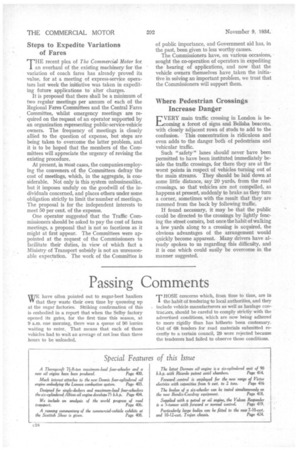Steps to Expedite Variations of Fares
Page 48

If you've noticed an error in this article please click here to report it so we can fix it.
THE recent plea of The Commercial Motor for an overhaul of the existing machinery for the variation of coach fares has already proved its value, for at a meeting of express-service operators last week the initiative was taken in expediting future applications to alter charges.
It is proposed that there shall be a minimum of two regular meetings per annum of each of the Regional Fares Committees and the Central Fares Committee, whilst emergency meetings are required on the request of an operator supported by an organization representing public-service-vehicle owners. The frequency of meetings is closely allied to the question of expense, but steps are being taken to overcome the latter problem, and it is to be hoped that the members of the Committees will appreciate the urgency of revising the existing procedure.
At present, in most cases, the companies employing the conveners of the Committees defray the cost of meetings, which, in the aggregate, is considerable. Not only is this system unbusinesslike, but it imposes unduly on the goodwill of the individuals concerned, and places others under some obligation strictly to limit the number of meetings. The proposal is for the independent interests to meet 50 per cent. of the expense.
One operator suggested that the Traffic Commissioners should be asked to pay the cost of fares meetings, a proposal that is not so facetious as it might at first appear. The Committees were appointed at the request of the Commissioners to facilitate their duties, in view of which fact a Ministry of Transport subsidy is not an unreasonable expectation. The work of the Committee is of public importance, and Government aid has, in the past, been given to less worthy causes.
The Commissioners have, on various occasions, sought the co-operation of operators in expediting the hearing of applications, and now that the vehicle owners themselves have ;taken the initiative in solving an important problem, we trust that the Commissioners will support them.
Where Pedestrian Crossings Increase Danger
rVERY main traffic crossing in London is be 4 1 coming a forest of signs and Belisha beacons, with closely adjacent rows of studs to add to the confusion. This concentration is ridiculous and even adds to the danger both of pedestrians and vehicular traffic.
Such " safety " lanes should never have been permitted to have been instituted immediately beside the traffic crossings, for there they are at the worst points in respect of vehicles turning out of the main streams. They should be laid down at some little distance, say 20 yards, from the road crossings, so that vehicles are not compelled, as happens at present, suddenly to brake as they turn a corner, sometimes with the result that they are rammed from the back by following traffic.
If found necessary, it may be that the public could be directed to the crossings by lightly fencing the street corners, but once the habit of walking a few yards along to a crossing is acquired, the obvious advantages of the arrangement would quickly become apparent. Many drivers have already spoken to us regarding this difficulty, and it is one which could easily be overcome in the manner suggested.
























































































































